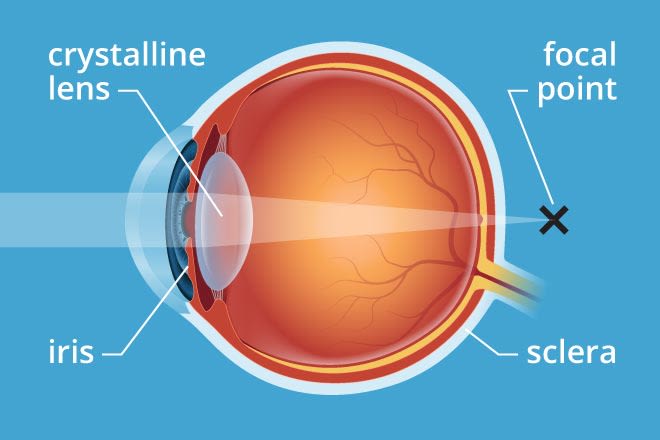Presbyopia: Causes, symptoms and treatment

Presbyopia is the normal loss of near focusing ability that occurs with age. Most people begin to notice the effects of presbyopia sometime after age 40, when they start having trouble seeing small print clearly — including text messages on their phone.
You can't escape presbyopia, even if you've never had a vision problem before. Even people who are short sighted will notice that their near vision blurs when they wear their glasses or contact lenses to correct distance vision.

The eye's lens stiffens with age, so it is less able to focus when you view something up close.
Researchers estimate that nearly 2 billion people worldwide have presbyopia.
Though presbyopia is a normal change in our eyes as we age, it often is a significant and emotional event because it's a sign of ageing that's impossible to ignore and difficult to hide.
In parts of the world where there is no access to vision care, presbyopia is much more than an inconvenience — it's a leading cause of vision impairment that reduces people's quality of life and productivity.
Presbyopia symptoms
When you become presbyopic, you have to hold your mobile phone and other objects and reading material (books, magazines, menus, labels, etc.) further away from your eyes to see them more clearly.
Unfortunately, when we move things further away from our eyes they get smaller in size, so this is only a temporary solution to presbyopia.
If you can still see close objects pretty well, presbyopia can cause headaches, eye strain and visual fatigue that makes reading and other near vision tasks less comfortable and more tiring.
What causes presbyopia?
Presbyopia is an age-related process. It is a gradual thickening and loss of flexibility of the natural lens inside your eye.
These age-related changes occur within the proteins in the lens, making the lens bigger and less elastic over time. With a bigger less elastic lens, it gets difficult for the eyes to focus on close objects.
Presbyopia treatment
Presbyopia can be treated with glasses (including progressive lenses and reading glasses), contact lenses and vision surgery.
Glasses
Spectacles with progressive lenses are the modern and most popular solution for presbyopia for most people over age 40. These 'multifocal' lenses restore clear near vision and provide excellent vision at all distances.
Another option is bifocal lenses, but bifocals provide a more limited range of vision for many people with presbyopia and they have an obvious tell-tale line across the lens.
It's also common for people with presbyopia to notice they are becoming more sensitive to light and glare due to ageing changes in their eyes. Photochromic lenses, which darken automatically in sunlight, are a good choice for this reason.
Reading glasses are another choice. Unlike bifocals and progressive lenses, which most people can leave on their face until they have finished their tasks, reading glasses are worn only for close objects and small print, so they have to be taken on and off all day.
If you wear contact lenses, your optometrist, can prescribe a variety of glasses for your near vision that you wear while your contact lenses are in. Your optometrist can present the best solution for your needs.
Regardless which type of spectacles you choose to correct presbyopia, definitely consider lenses that include anti-reflection coating. Anti-reflection coating eliminates reflections that can be distracting and cause eye strain. It also helps reduce ghost images and increase visual clarity for night driving.
Contact lenses
People with presbyopia also can opt for multifocal contact lenses, available in gas permeable or soft lens materials.
Another type of contact lens correction for presbyopia is monovision, in which one eye wears a distance prescription, and the other wears a prescription for near vision. The brain learns to favour one eye or the other for different tasks.
While some people are delighted with this solution, others complain of reduced visual acuity and some loss of depth perception. Because the human eye changes as you grow older, your presbyopia glasses or contacts prescription will need to be changed over time as well. You can expect your optometrist to prescribe the right correction for near work as you need it.
Presbyopia surgery
If you don't want to wear glasses or contact lenses for presbyopia, a number of surgical options to treat presbyopia are available as well.
One presbyopia correction procedure that's gaining popularity is implantation of a corneal inlay.
Typically implanted in the cornea of the eye that's not your dominant eye, a corneal inlay increases depth of focus of the treated eye and reduces the need for reading glasses without significantly affecting the quality of your distance vision.
The first step to see if you are a good patient for presbyopia surgery is to have a comprehensive eye exam with your optometrist who will refer you for a consultation with a refractive surgeon who specialises in the surgical correction of presbyopia.
Presbyopia is a part of growing older
Presbyopia is a normal part of the ageing process, and we’re all going to have to deal with it sometime after age 40. Whichever option you choose – spectacles, contact lenses or surgery – you’ll be able to easily read messages on your phone or a book to your kids without any trouble.
If you are beginning to notice signs and symptoms of presbyopia, see an optometrist near you, for an eye test and consultation regarding the best presbyopia treatment options for you.
Page published on Monday, 16 March 2020






